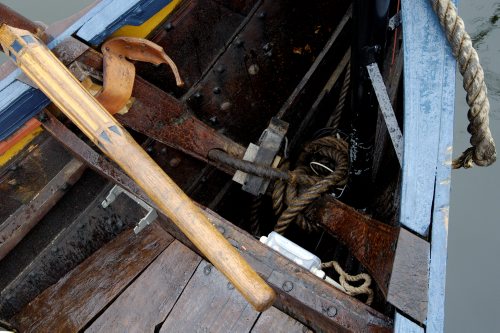Today we made general inspection of the ship.
The wicker-band for the rudder were untied and then tightened in the holes in the rudder bulkhead (For further information, see the front page of "havhingsten.dk" and choose "Welcome Aboard". Here You can see how the rudder system on the Sea Stallion is put together).
With these ajustments the rudder system is up and running, and the ship is ready to sail without the chaintackle as emergency system.
The axle for the wheel in the masthead has been smeared with tallow. This prevents the wheel from tearing on the axle when the sail is up and puts weight on the wheel. - The parrel (the sliding loop that holds the yard and the sail in to the mast) has also been smeared with tallow - otherwise it tears on the mast. Especially when we reef the sail (makes the surface smaller) so it only goes halfway up the mast, the pressure on the mast from the parrel is substantial. To relieve the pressure on the mast, we haul backwards in rope for the parrel.
The floor timbers have been inspected, in particular the wedges and the nails have been checked after the twisting and turning of the hull during yesterdays sailing. They were all as the they should be. - The stringer in the forebody has been pulled back in place and re-attached with new wedges.
The ship was baled out yesterday during the night and again this afternoon. The ship is not taking in water, when it is lying still. This means, that the 2-300 liters of water, that we baled out during sailing, was from the oarports and not from leaks in the hull.
Wednesday, July 4th.
Today we have been rowing and tacking (sailing up against the wind) and we were towed by our support vessel 'Cable One'. The towrope is fastened to the mast and continues to the forestem, where it is lying between the bitts. This way the hull is gently pulled foward, even when the ship is going up and down in the swell.
MT
